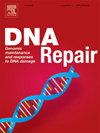Synthetic cytotoxicity profiling of cohesin mutants highlights recombination-based dependencies
IF 2.7
3区 生物学
Q2 GENETICS & HEREDITY
引用次数: 0
Abstract
Cohesin maintains genome integrity through its ability to bind and link DNA molecules via a Structural Maintenance of Chromatin (SMC) activity. These effects are manifested through its major function in sister chromatid cohesion, but also through activities during DNA replication, repair, and transcription. The array of cohesin functions can make interpreting cellular effects of cohesin loss difficult to interpret mechanistically. This is particularly important in cancer where cohesin subunit mutations are common, and where the identification of genetic dependencies would be useful for predicting the response of cohesin-mutated cells to genotoxic challenges. Here we performed a series of synthetic cytotoxicity screens with hypomorphic cohesin alleles in yeast to identify cellular pathways whose loss sensitizes cohesin-mutants to sublethal levels of genotoxic DNA damage. This dataset reveals important roles for cohesin in replication stress and homologous recombination regulation that can leave cohesin mutated cells with a dependency on translesion synthesis for survival.
内聚蛋白突变体的合成细胞毒性分析强调了基于重组的依赖性
内聚蛋白通过染色质结构维持(SMC)活性来结合和连接DNA分子,从而维持基因组的完整性。这些作用通过其在姐妹染色单体内聚中的主要功能以及在DNA复制、修复和转录过程中的活动表现出来。内聚蛋白功能的多样性使得内聚蛋白损失对细胞的影响难以从机制上解释。这在癌症中尤其重要,因为黏合蛋白亚基突变是常见的,并且遗传依赖性的鉴定将有助于预测黏合蛋白突变细胞对基因毒性挑战的反应。在这里,我们用酵母中的半形黏合蛋白等位基因进行了一系列的合成细胞毒性筛选,以确定细胞通路,其丢失使黏合蛋白突变体致敏到亚致死水平的基因毒性DNA损伤。该数据集揭示了内聚蛋白在复制胁迫和同源重组调控中的重要作用,这些调控可以使内聚蛋白突变的细胞依赖翻译合成来生存。
本文章由计算机程序翻译,如有差异,请以英文原文为准。
求助全文
约1分钟内获得全文
求助全文
来源期刊

DNA Repair
生物-毒理学
CiteScore
7.60
自引率
5.30%
发文量
91
审稿时长
59 days
期刊介绍:
DNA Repair provides a forum for the comprehensive coverage of DNA repair and cellular responses to DNA damage. The journal publishes original observations on genetic, cellular, biochemical, structural and molecular aspects of DNA repair, mutagenesis, cell cycle regulation, apoptosis and other biological responses in cells exposed to genomic insult, as well as their relationship to human disease.
DNA Repair publishes full-length research articles, brief reports on research, and reviews. The journal welcomes articles describing databases, methods and new technologies supporting research on DNA repair and responses to DNA damage. Letters to the Editor, hot topics and classics in DNA repair, historical reflections, book reviews and meeting reports also will be considered for publication.
 求助内容:
求助内容: 应助结果提醒方式:
应助结果提醒方式:


